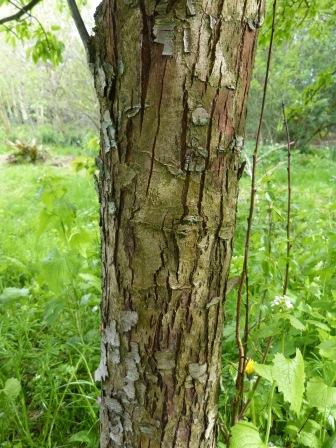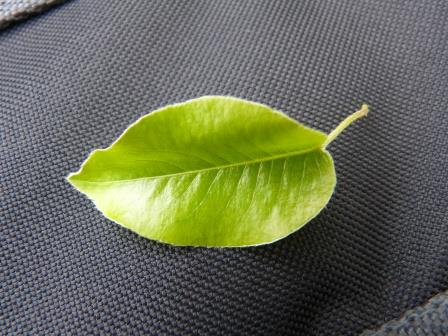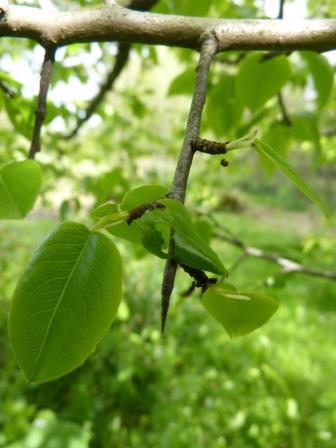By Sean Fagan
.
Learn about the History & Key Identification Features of Wild Pear
&
5 Bushcraft Virtues of Wild Pear
..Distribution of Wild Pear:
Ireland: not native, occasionally naturalised.
Europe: most likely native to southern Britain. In mainland Europe - from France and Germany to Mediterranean.
Asia: Northern Asia Minor to Northern Iran, Central Asia
.
Although the wild pear is currently uncommon in Ireland it has a long pedigree of occupation in Ireland.
The origins of wild pear in Ireland is unclear but is most likely a 'feral' variety of the closely related domestic pear, Pyrus communis, with records of cultivation in Ireland since the early 1600's.
The wild pear is a interesting tree – it belongs to the Rosaceae (rose) family with such notable ‘fruit tree’ characteristics that is typical of many Rosaceae trees.
Wild pears typically produce small 1-4cm diameter pears that are often hard - until they ripen in later summer and early autumn.
However, boiling hard pears will soften them into a palatable fruit.
Baking and roasting pears are alternative cooking options that can offer more flavour than boiling.
..
.
IDENTIFICATION OF WILD PEAR
.
Pyrus pyraster
Rosaceae (Rose family)
Irish Name: Piorra Fiann
Wild pear is generally a small tree (15 metres) and can easily be missed when part of a hedgerow or open woodland – both typical wild pear habitats.
The key identification features of pear trees are the bark, the leaves and the long thorns and to a lesser extent, the flowers.
.
BARK
Craggy & Cracked
.
The colour of the bark is predominantly brown, often grey – occasionally a combination of grey and brown.
The bark, for such a small tree, is typical of a lot of small trunk diameter trees that belong to the Rosaceae family, which has deep, mostly vertical, fissuring - often scaly (especially in mature trees).
.

The grey-brown, deeply cracked, flaky bark of pear. For such a small diameter tree, the bark of mature pear trees appear remarkably old and weathered (photo: Sean Fagan).
.
.
LEAVES
Glossy-Smooth Leaf with or without Finely-Toothed Edge
.
The stalked leaves are smooth. The shape of the pointed leaves vary from spear-shape to rounded. Even the round leaf variant can be pointed at the end. The leaf margins are either finely serrated or smooth-edged.

The glossy-smooth, pointed, pear leaf. This pear leaf does not have a serrated edge although some pear leaves do. Also, some pear leaves have a more rounded shape than leaf in photo above (photo: Sean Fagan).
.
THORNS
.Long & Very Sharp
.
A key difference between the wild pear and cultivated varieties of pear such as the domesticated pear, Pyrus communis, is that the twigs of wild pear possess formidable thorns – often several centimetres long.
From an evolutionary perspective, this makes a certain amount of sense. Wild trees often have thorns as a means of physical protection against herbivores. Domesticated forms of trees, usually over generations of cultivation by humans do not have thorns (because they would be cumbersome for humans).
It's remarkable, the ancestor of the wild pear - the domestic pear, is believed to have been cultivated in Ireland from the early 1600's. Throughout the centuries since domestic pear was cultivated in Ireland, escapee domestic pear trees have morphed into its present manifestation - the wild pear - complete with a thorny armoury to enable it to survive the herbivorous onslaughts that the Irish countryside has thrown at it.
Interestingly, the domestic pear is thought to have been originally derived from two varieties of wild pear.
Curiously, the pear gene for thorns was most likely dormant in domestic pear, but once outside the cultivating influence of man, reverted to a wilder, more thorny state.
Other thorn-bearing Rosaceae tree species in Ireland & Britain include blackthorn and hawthorn.
(Tip: the tough thorns of the Rosaceae trees make great outdoor clothing pins, toothpicks and, when properly made, fishing hooks).
.

The wild pear tree, like the closely related blackthorn and hawthorn, possess some of the most formidable thorns of all the thorn-bearing tree species in Ireland, Britain & Europe (Photo: Sean Fagan).
.
.
FLOWERS
Five Beautiful Bright Petals
.
The flowers of the pear are unusual yet still belie the tell-tale features of all Rosaceae trees, which typically have five, prominent, separate petals along with five splayed sepals.
Colour-wise, the 5 separate petals are usually a distinctive bright white colour. The anthers of the numerous stamens in each flower often have a dark, chocolate colour.
.
![PearBlossomsCalifornia[1]](http://www.pioneerbushcraft.org/wp-content/uploads/2015/05/PearBlossomsCalifornia1-1024x680.jpg)
Typical of all trees belonging to the Rosaceae family, pear trees have flowers with five petals. Note prominent, dark-tipped stamens, the yellow, pointed sepals and the 5, widely-splayed, separate, blunt flower petals (photo: Wikimedia commons).
..
.
.
USEFUL APPLICATIONS OF WILD PEAR WOOD
“The pear is one of the finest woods for carving”
.
Pear wood, like most trees of the Rose family, is a great carving wood.
The pinky-brown, finely-grained, tough wood of pear is suitable for a whole slew of bushcraft and camping carving projects especially where toughness and durability is required such as axe & knife handles, mallets & batons.
An added advantage of carving with a dense, tough wood is that the wood can, due to a lack of brittleness, hold very fine details.
![02fdb3e1a25f22dff68463130803d3ff[1]](http://www.pioneerbushcraft.org/wp-content/uploads/2015/05/02fdb3e1a25f22dff68463130803d3ff1.jpg)
Hand-carved spoons made from pear wood. The unique aesthetics, texture and durability of pear wood make it a popular choice for wood turners and hand-carvers alike (Photo: Wikimedia Commons).
.
The dense wood of pear burns hot and long and often emits, like the wood from many Rosaceae trees, a pleasant fragrance when burned.
If you get the impression I have a soft spot for the wild pear you would be right.
Nationally uncommon, a diminutive, non-showy tree with tough, pretty wood which burns hot, long and fragrant – the wild pear is always a surprising treat whenever I stumble upon its presence in the wild.
In a way, the wild pear is a marker of times past – when trees were more common in our landscape - a reminder of a more wooded, wilder past.
You might pose the question - what’s the point in getting to know the pear tree if it’s uncommon?
.
Here are FIVE answers to that question:
1. MEMBER OF ROSACEAE FAMILY
Wild pear belong to the Rosaceae plant family – so finding a pear tree and scrutinising its key identification features will deepen your knowledge of the important Rosaceae family – which contains quite a few important, widely distributed, common tree species that have numerous outdoor applications.
Notable Rosaceae trees, in Ireland and Britain - are hawthorn, rowan, wild cherry, blackthorn, whitebeam and wild/crab apple.
Key Rosaceae tree features are the five brightly coloured, separate petals of the flowers, the presence of a fleshy fruit containing a ‘stone’ seed and the overall size of mature, Roseaceae trees is also key – as they often small trees.
Although the emphasis for the budding bushcraft botanist should be focused on learning thoroughly, the more common, widespread tree species there is, at least in Ireland and Britain, a relatively limited number of widespread, common tree species. It's good to stretch your tree knowledge to the less common tree species, especially since common and rare tree species are often related and share a commonality of key Identification features.
2. WILD FRUIT
The pear tree produces pears – a fruit that can be, in bushcraft and survival terms, important. Often the pears on the tree are obscured by foliage so if you can recognise the bark, tree shape, thorns and leaves of wild pear you can then start to look for the fruit (remember, pears can be quite hard - don't forget to boil them to soften).
3. CARVING WOOD
As already stated in this article – the tough, attractive wood of pear is great for carving projects.4. FUEL
Dead, seasoned pear wood is a valuable source of high quality fuel for the campfire. Also, the thin, dead twigs still attached to pear trees make for great kindling.5. FOLKORE & TRADITIONAL USES
The pear tree has a long and distinguished history in Ireland and undoubtedly in other countries across its native and non-native geographic range. Knowing of the history of the pear tree, its folklore and traditional uses, can deepen our understanding and admiration of the wild pear - indeed, of nature in general.
.
Although the earliest records of pear trees being cultivated in Ireland hail from the early 1600's, there is one anomaly that indicates that the pear tree has been in Ireland for longer.
The neck of the famous Fitzgerald-Kildare harp, believed to be dated from the late 1500's, was made from pear wood.
Historically, wherever wild fruit trees occur geographically, they have been steeped in folklore and for good reason. Such trees, including wild and domestic pear trees, provided a valuable source of fruit.
Combined with the facts that fruit trees, especially those of the Rosaceae trees, possess tough, attractive wood that is ideal for carving and the dense wood of most fruit trees are a source of hot fuel, its little wonder that fruit trees have been revered for many millennia.
.
Outdoor Tip: ORCHARDS ARE OFTEN WILDLIFE HOT SPOTS
.
Scattered across Ireland, Britain and mainland Europe there are many abandoned rural buildings with orchards, such as monasteries, convents and old farm buildings.
Many of these buildings have significantly deteriorated, often to ground level.
What is often left - indicating the presence of these old rural buildings, is the presence of an orchard.
Finding an abandoned pear-tree orchard is a delight to behold especially when the trees are blossoming. The thick mass of bright flowers that dominate such orchards are often alive with hoverflies, butterflies, bees, wasps and bumblebees - all sipping heartily on the nectar of pear flowers.
Orchards are often wildlife hotspots for many omnivorous and herbivorous mammals such as the red fox, badger, hedgehog, pine marten, deer and boar - all commonly availing of the bounty of fallen fruit in late summer and early autumn (hot tip: abandoned orchards are great for setting up wildlife camera traps - due to the high volume of animal traffic).
The rich insect life of orchards usually attract a high concentration of insectivorous birds such as the blackcap, willow warbler, chiff-chaff, blue tit, coal tit, great tit, wren and goldcrest.
It’s a real nature treat to be in such a place.
I urge you to seek these places out and enjoy them.
(P.S. I am not advocating, in any way, the illegal entry or illegal camping, on private property. However, asking permission to camp on private grounds such as abandoned orchards can be surprisingly fruitful (dreadful pun)).
.
A WILD ENCOUNTER WITH A FRENCH ORCHARD
.
Once, in France, I came across a large, isolated, abandoned apple and pear orchard adjoining a large wood. Upon the ground, lay hundreds of staggering honey bees, wasps, butterflies and a few formidable hornets – most were in a drunken stupor caused by eating fallen, fermented pears and apples. A bizarre sight.
Fox, hedgehog and wood mouse tracks, scat and trails were scattered throughout the orchard.
And on the uppermost branch of the tallest pear tree in the orchard, sang a golden oriole. Its flute-like, clear song filling the orchard air.
What a place.
No wonder I camped near that orchard for a few days…
And no wonder boiled pears featured highly in my diet for those few days : )
Dusk was special in the orchard. As the last light of sunset smouldered into darkness, the ethereal white form of a solitary barn owl would silently float over the orchard...searching for a meal.
Moments such as these – are yours for the taking – for nature is a generous and surprising host.
With some food, the right outdoor gear, skills and knowledge accompanied with a hunger for adventure - you can encounter these places, relatively unencumbered and free to explore… and just be.
.
Have Safe & Grand Adventures,
Pioneer Bushcraft.
.
.
Related articles on this website:
- Bushcraft Tree Lore: The Holly Tree
- Bushcraft Tree Lore: The Sycamore
- Identifying the Poisonous Fool’s Parsley
- How Urban Botany will Improve your Bushcraft
.
References & Useful Links:
- Trees of Ireland, Native and Naturalized, E. Charles Nelson & Wendy F. Walsh.
.
.
.
Bonus Pear Facts
.
The aromatic firewood of pear timber was traditionally used to smoke and flavour meat.
Pear wood is renowned for not warping – making it an ideal choice for wooden precision instruments such as T-squares.
There are believed to be about 3,000 known varieties of domestic pear grown worldwide.
Pears are believed to be one of the oldest cultivated fruits – originating from western china 3,000 years ago.
Before tobacco was introduced in Europe, pear leaves were smoked.
Pear wood is used to make furniture, musical instruments, wood carvings and wooden kitchen utensils.
.
.
.
PIONEER BUSHCRAFT DISCLAIMER
.
Pioneer Bushcraft does not take responsibility for the misapplication of the advice dispensed in this article.
The aim of this article is to provide bushcraft applications for the pear tree – it’s not the wish of Pioneer Bushcraft to encourage over-exploitation of natural resources, such as pear trees.
Please, use good judgement when using natural resources. Only take what is needed and always have in mind: how much can be sustainably harvested from an area, which does not cause significant, long-term damage?
If you’re planning on repeatedly using an area for bushcraft practise you must be vigilant against over-exploiting vulnerable natural resources or you run the risk of greatly impoverishing your practise area.
In a sense, I’m encouraging a role of stewardship.
Taking pride in caring for an area will enable you to become more attuned to, and more responsible about, the ecological health of a wild place that you frequent.
It’s important for all those who practice bushcraft responsibly.
![1379050[1]i](http://www.pioneerbushcraft.org/wp-content/uploads/2015/05/13790501i.jpg)

Recent Comments